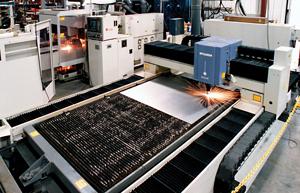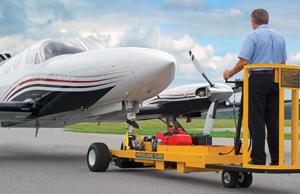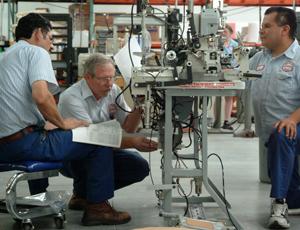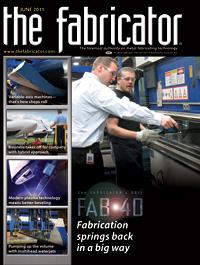Senior Editor
- FMA
- The Fabricator
- FABTECH
- Canadian Metalworking
Categories
- Additive Manufacturing
- Aluminum Welding
- Arc Welding
- Assembly and Joining
- Automation and Robotics
- Bending and Forming
- Consumables
- Cutting and Weld Prep
- Electric Vehicles
- En Español
- Finishing
- Hydroforming
- Laser Cutting
- Laser Welding
- Machining
- Manufacturing Software
- Materials Handling
- Metals/Materials
- Oxyfuel Cutting
- Plasma Cutting
- Power Tools
- Punching and Other Holemaking
- Roll Forming
- Safety
- Sawing
- Shearing
- Shop Management
- Testing and Measuring
- Tube and Pipe Fabrication
- Tube and Pipe Production
- Waterjet Cutting
Industry Directory
Webcasts
Podcasts
FAB 40
Advertise
Subscribe
Account Login
Search
The merits of a manufacturing hybrid
Shop juggles fabrication, assembly, in-house product lines, and contract work
- By Tim Heston
- June 2, 2011
- Article
- Assembly and Joining

Figure 1: Atlanta Attachment’s shop floor is set up as a hybrid—part product line manufacturer, part job shop.
When Atlanta Precision Machining & Fabrication opened for business, it immediately became a significant job shop in the metro area, at least as measured by manufacturing capacity. That's because it wasn't just a job shop but a subsidiary of Atlanta Attachment Co., a manufacturer of bed-making equipment, sewing workstations, and maintenance products for private aviators.
The recession gave Atlanta Attachment a one-two punch. The market for capital equipment overall plummeted as well as the housing market, and Atlanta Attachment's textile machinery related to both. Mark Tullis knew this all too well. He had spent 25 years with the company, but in 2008 he found an opportunity elsewhere. At the time he felt it was a good move; after all, Atlanta Attachment was struggling. The situation didn't pan out at his new employer, though, so by early 2009 he was, like so many others, unemployed.
One day Tullis had lunch with old friends from Atlanta Attachment. He knew the company's Lawrenceville, Ga., facility had Amada press brakes, a Flow waterjet machine, Mitsubishi laser cutting equipment, Timesavers flat-part deburring equipment, rows of Haas machining centers, a wet paint shop, as well as extensive mechanical and electromechanical assembly capabilities (see Figures 1-3). He also knew the company's textile machinery sales continued to struggle. So during that lunch, Tullis asked a logical question: Why not sell that excess capacity to other shops that needed parts?
His tablemates smiled, and a few days later Tullis had a job again. With the go-ahead from the company founder, Tullis put together brochures and went out on the road to sell, acting as area manager of the newly founded Atlanta Precision Machining & Fabrication LLC.
The job shop launch didn't require a dramatic shop floor overhaul. Atlanta Attachment has always resembled a job shop. The company has product lines, but it manufactures most to customer specifications. This isn't a cookie-cutter business. A good portion of manufacturing activity is make-to-order, not make-to-forecast. And make-to-order is, of course, the essence of the job shop business.
Folder Beginnings
Atlanta Attachment's name comes from a small component on automated sewing equipment that even today requires hand tools and high operator skill to make—and the first to make one at the company was Elvin C. Price, the founder.
Price was selling sewing machines to the apparel industry in the 1960s when he had an idea to make his job easier. Many textile plants wanted a unique folder attachment for their sewing workstations. Connected to the sewing head, each folder—as the name suggests—would fold fabric in a specific way suited for the garment.
"These pieces are custom-fabricated by hand for every machine," Tullis said. "Unfortunately, he was having trouble with one of his suppliers [of folding attachments], which would never ship in time."
To speed the process and save money, Price went to his basement and fabricated the folder attachments himself with simple hand tools: a snip here, a bend there. Each folder he made was different, and each had to be cut and bent just so. Otherwise, the fabric would catch or be folded improperly. A large machine costing thousands wouldn't work if a small, seemingly insignificant folder attachment was fabricated improperly. This bit of stainless steel, formed and folded uniquely for every product, launched Atlanta Attachment in 1969 (see Figure 4).
"This is skilled labor," said Ronnie Ford, Atlanta Attachment's CFO. "You need to make sure there are no burrs, and everything has to be as smooth as it can be so it doesn't catch the material."
Tullis quipped: "When spandex and Lycra® came out, we thought it was the end of the world. We had to learn to make folder attachments for that material, and it stretched in every direction. It was a real undertaking."
He subsequently held up a folder that solved the problem. It's made of what Tullis called "crinkle material"—essentially extremely thin metal formed with microridges. The ridges themselves are smooth enough not to catch the fabric, but offer enough resistance to ensure stretchy material folds properly as it travels into the sewing workstation.
Diversification
Statistically, Price's company shouldn't be in business today. An equipment-maker serving the textile industry, a sector that in the U.S. was brutally affected by globalization, the company could have followed the stereotypical rise and fall of stateside manufacturing.
But it didn't. It adapted, as proved by its melting pot of subsidiaries. In 1997 Price, an amateur pilot, launched Priceless Plane Products LLC, which makes tugs and portable ground power units for the private aviation sector (see Figure 5). The core Atlanta Attachment business broadened its focus to automated machines for mattress-making, a sector not as affected by globalization. (Mattresses aren't easy to ship overseas.) Managers also launched Atlanta Parts Depot, a business that makes and distributes spare parts for bedding equipment.
If you walked around the shop floor and didn't know Atlanta Attachment made bedding machinery, you would think you were standing in the middle of a large job shop. Even color-coded job travelers—a job shop mainstay—follow work around the floor. Job routings vary greatly, depending on the product, and the color of the job packet shows an operator which business the job is for.
Manager of Metals Processing Rick Park pointed to a stack of blue papers signifying Atlanta Attachment orders. So with parts for Atlanta Precision, Atlanta Attachment, Priceless Plane Products, Atlanta Parts Depot, prototypes for R&D, and parts for machine refurbishing flowing through the metal shop, how often does the schedule change? Park chuckled. "Oh, about every five minutes. We're dedicated to quick change."
He was only half joking. Schedules do change frequently to meet changing demands. The shop is tooled up for flexible manufacturing. Jobs having 10 or fewer piece-parts are common.
Atlanta Attachment has always been a high-mix environment, which explains the rationale behind the shop layout. The machining, bending, cutting, welding, grinding, and painting departments feed fabricated and painted parts to several assembly areas, one dedicated to machine refurbishing, another for aviation products, and another for textile machinery. It looks much like a job shop, just with greatly expanded assembly departments set up for workers to put together large, complicated machines.
Value in Assembly
When Tullis began selling Atlanta Precision's capabilities, he first wanted to find companies that needed fabricated parts. He quoted work based on part drawings, like any job shop estimator would do.
As the economy slowly emerged from the recession, though, Tullis noticed a trend. Some local OEMs had downsized significantly, and by 2010 they were left with a bare-bones staff of extremely skilled employees adept at making the companies' most sophisticated, custom, and often most profitable products. Most who lost their jobs produced the companies' "cookie-cutter" product lines of standard machines with little if any customization. As demand began to pick up, OEM managers had a choice: Do they rehire those cookie-cutter-machine workers, or do they outsource?

Figure 3: The shop has several flat-sheet laser cutting systems that feed products to other areas of the plant, including finishing and electromechancial assembly.
As Tullis discovered, some decided to outsource to local companies—and for good reason. Demand for standardized machines always was highly variable. Workers came and went, even in good times, and the recession forced some to cut so much that managers decided to alter their business strategies.
They sold off aging manufacturing equipment and refocused in-house operations on highly customized work. They got out of standardized manufacturing entirely, sending that variable-demand work to contract manufacturers that offered not just parts manufacturing, not even just subassemblies, but wraparound service, from fabrication to final assembly and testing.
This happens to be Atlanta Precision's forte. For example, a local packaging equipment-maker now manufactures only highly customized machines in-house and sends its cookie-cutter systems over to Atlanta Precision, which offers wraparound service. It manages the supply chain for any parts it can't make in-house (which isn't many), then fabricates, paints, assembles, and tests the machines. The company then delivers the finished product to the customer, which conducts final testing before sending it out the door (see Figure 6).
Streamlining Custom Assembly
Certain machine parts are staged only steps away from assembly workstations and are replenished as needed. But this applies only to the company's standard machines. In recent years Atlanta Attachment has built its niche with customized sewing machinery. "That's basically why we've been able to stay in business while so many of our competitors went out of business," Ford said. "We're open for change."
Because so many jobs are unique, managers have worked to streamline assembly operations wherever they can. For instance, instead of traditional, sprawling electrical diagrams, assemblers work with compact, color-coded, multilayered prints generated by SolidWorks®. Every page shows wire connections for a single color. That way, assemblers connect wires of one color, flip the page for the next color, and so on.
Upstairs from the main shop floor is a quieter office with limited access. It's Atlanta Attachment's R&D center. "During the recession we invested highly in research and development," said Ford. "This meant we were able to bring out new products into the industry that have helped us get the backlog that we have today. At the 2010 ISPA [a textile industry tradeshow (see Figure 7)], we brought 14 new pieces of equipment, and our competitors were showing the same products they had been showing for years."
R&D operates just a few yards away from the company's control box assembly department, grouped together mainly because both R&D and electrical assembly require extremely clean environments. But there's another reason too: Engineers talk with electrical assemblers to ensure new machine designs make sense from an electrical assembly perspective. The proximity fosters collaboration. In the R&D area, engineers dream up new designs on the computer, order parts from the fabrication area, and then actually build a machine. There is no such thing as throwing a design "over the wall" to manufacturing. There is no wall, literally and figuratively.
Such a system gives Tullis another selling point for the job shop business: a robust R&D and design engineering staff. A customer can come to Atlanta Precision with only an idea and a rough sketch, and the job shop can take the project from there. (One such customer walked into Tullis' office just hours after our meeting in April.)
For some customers the job shop offers yet another service: product distribution. With Atlanta Parts Depot, the company already has a toehold in the distribution business, and it makes sense to offer the service for certain customers, like one that consists literally of a person sitting in a home office in front of a computer. His Web page is his storefront. Atlanta Precision doesn't offer stamping, so the customer has a stamping house send formed parts to Tullis' shop. From there Atlanta Precision fabricates, paints, assembles, tests, and distributes his product. This arrangement wouldn't be practical for many products, of course, particularly those of high complexity or volume. But the arrangement does reveal a trend of supply chain simplification.
About Risk
Atlanta Attachment managers have discovered design, manufacturing, and product delivery as company strengths, and they offer them to the several dozen markets serviced by the job shop division, which today accounts for more than $2 million of the company's overall annual revenue of $30 million.

Figure 5: This tug, manufactured by Atlanta Attachment’s Priceless Plane Products division, helps service the company plane, which sometimes is used to deliver parts for customers in emergencies.
It's still been quite a roller coaster ride. In the 1990s the company earned about $30 million a year, until globalization changed the textile industry in a big way. After the dot-com bust, revenue dropped to only $8 million. Earnings then crept steadily upward before being knocked down again to $15 million in 2009. This past recession hit the company especially quickly. "Went from 140 people to 73 people in two months," Ford said. "And those layoffs included people in manufacturing management."
Today revenue is back to $30 million, the same level it was during the 1990s boom years, and the company is hiring. Currently more than 170 are on the payroll.
It continues to be about managing risk. When Price launched Atlanta Attachment, it grew on the back of the apparel industry. To mitigate that risk, he broadened the company's focus to equipment for making mattresses and automotive upholstery, and introduced new products for the private aviation sector, a completely different industry. He launched a parts distribution business, offered machine refurbishing services, and then finally opened a full-fledged job shop. Managers hope that such diversification will lead to steady growth, and perhaps make dramatic revenue fluctuations a thing of the past.
Atlanta Precision's customers may want to step away from manufacturing, again to mitigate risk. After this latest recession, they're tired of the seemingly unending cycle of laying off and rehiring. For them, manufacturing's high capital investments are just too risky—and managers at Atlanta Precision would undoubtedly be happy to take the risk of manufacturing off their hands.
Photos provided by Atlanta Precision Machining & Fabrication, 362 Industrial Park Drive, Lawrenceville, GA 30046, 770-277-4200, www.atlantaprecision.com.
New Building, High Design
Atlanta Attachment Co.'s 220,000-square-foot building in Lawrenceville, Ga., does not typify a manufacturing facility. Flags outside represent all the countries the company exports to, including Australia and New Zealand. Across the street is Gwinnett County Airport, where a plane stands at the ready to deliver emergency parts to customers. (That plane may put some muscle behind the company's decades-old tagline, Sudden Service®.) At the airport the company's Priceless Plane Products subsidiary tests and demonstrates its tugs and maintenance equipment.
Entering the building, visitors walk past a serene fountain and open a set of glass doors into a vast, open space. Its sleek design exudes the feel of a Fortune 100 company headquarters—not a 170-employee equipment manufacturer.
"An interior designer is a friend of [company founder Elvin Price's] family," said Ronnie Ford, CFO. "We wanted to go as natural and as green as possible in the design of the building."
Behind the front desk is a showroom for Atlanta Attachment's principal product lines. Upstairs, the front office has vaulted ceilings with a line of windows overhead. "Employees feel happier with natural light," said Ford, CFO.
The executive offices have glass walls, and cubicles are arranged to encourage collaboration. The plant floor is also well-lit with natural light, and it feels air-conditioned, even though it isn't. Massive fans (from a vendor whose name says it all, Big Ass Fans Co.)keep the air circulating.
Employees moved into the building in April 2007. "We used to be in three buildings," Ford said, "but the cost of moving parts between buildings became so expensive that we decided to consolidate into one facility. It was huge savings, from reduced utility bills to more efficient movement of inventory."
About the Author

Tim Heston
2135 Point Blvd
Elgin, IL 60123
815-381-1314
Tim Heston, The Fabricator's senior editor, has covered the metal fabrication industry since 1998, starting his career at the American Welding Society's Welding Journal. Since then he has covered the full range of metal fabrication processes, from stamping, bending, and cutting to grinding and polishing. He joined The Fabricator's staff in October 2007.
Related Companies
subscribe now

The Fabricator is North America's leading magazine for the metal forming and fabricating industry. The magazine delivers the news, technical articles, and case histories that enable fabricators to do their jobs more efficiently. The Fabricator has served the industry since 1970.
start your free subscription- Stay connected from anywhere

Easily access valuable industry resources now with full access to the digital edition of The Fabricator.

Easily access valuable industry resources now with full access to the digital edition of The Welder.

Easily access valuable industry resources now with full access to the digital edition of The Tube and Pipe Journal.
- Podcasting
- Podcast:
- The Fabricator Podcast
- Published:
- 04/16/2024
- Running Time:
- 63:29
In this episode of The Fabricator Podcast, Caleb Chamberlain, co-founder and CEO of OSH Cut, discusses his company’s...
- Trending Articles
Capturing, recording equipment inspection data for FMEA

Tips for creating sheet metal tubes with perforations

Are two heads better than one in fiber laser cutting?

Supporting the metal fabricating industry through FMA

Hypertherm Associates implements Rapyuta Robotics AMRs in warehouse

- Industry Events
16th Annual Safety Conference
- April 30 - May 1, 2024
- Elgin,
Pipe and Tube Conference
- May 21 - 22, 2024
- Omaha, NE
World-Class Roll Forming Workshop
- June 5 - 6, 2024
- Louisville, KY
Advanced Laser Application Workshop
- June 25 - 27, 2024
- Novi, MI




























